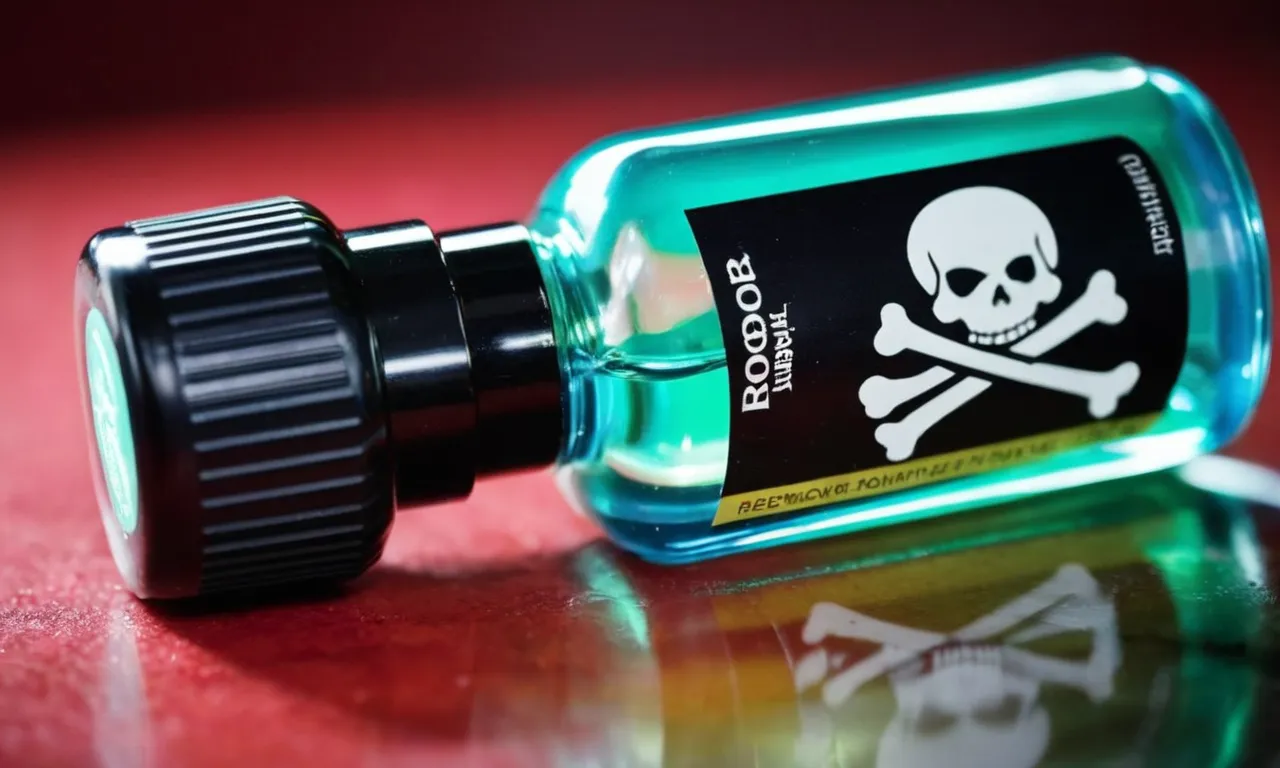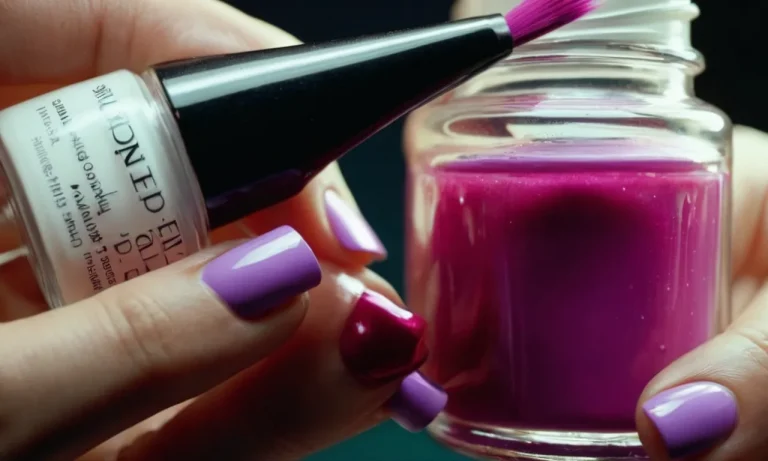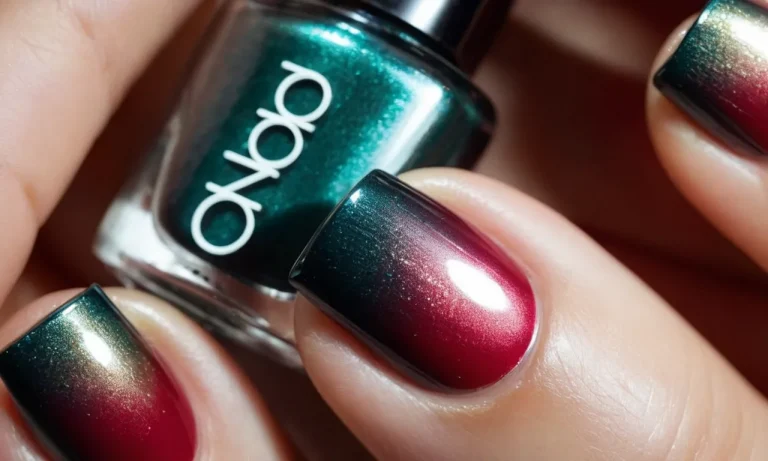Can Nail Polish Remover Kill You?
Nail polish remover contains chemicals like acetone, ethyl acetate, and butyl acetate which can be toxic if ingested or inhaled in large quantities. However, occasional exposure to small amounts during nail care is unlikely to cause serious harm.
If you’re short on time, here’s a quick answer to your question: While swallowing or inhaling large amounts of nail polish remover can kill you due to its ingredient acetone being toxic, using it as directed to remove nail polish is generally considered safe.
What’s in Nail Polish Remover
Acetone
Acetone is the primary solvent used in most nail polish removers. It is an effective solvent that breaks down the nail polish so it can be easily wiped off. Acetone works by dissolving the ingredients that make up nail lacquer, including the pigments, resins, and plasticizers.
It is able to break the bonds that hold the polish together on the nail surface.
Acetone is a harsh chemical that can dry out the nail and skin if used excessively. Most nail polish removers contain between 50-100% acetone. The higher the acetone concentration, the faster it removes polish but it can also cause more drying and irritation.
Using acetone-based removers too often can lead to brittle, peeling nails and dry, cracked skin around the cuticles. It’s best to use them in moderation.
Other Solvents
Some nail polish removers use other solvents instead of or in addition to acetone:
- Ethyl acetate – An organic compound that dissolves nail polish but is less harsh than acetone.
- Isopropyl alcohol – Also known as rubbing alcohol, it can remove polish but may require more scrubbing than acetone.
- Acetyl tributyl citrate – A non-acetone solvent derived from citric acid that is sometimes used in “acetone-free” removers.
- Methyl acetate – An organic solvent that is less drying than acetone but may have a strong odor.
These alternatives dissolve nail polish without completely dehydrating the nails and surrounding skin like acetone can. Non-acetone removers are gentler options but may require more time and effort to remove darker polishes.
Many brands now offer acetone-free options formulated with hydrating oils and moisturizers.
Dangers of Ingesting Nail Polish Remover
Can cause alcohol poisoning
Ingesting nail polish remover can be extremely hazardous due to its high alcohol content. Most nail polish removers contain 60-90% isopropyl alcohol which can rapidly lead to alcohol poisoning if consumed (1, 2).
According to the American Association of Poison Control Centers (AAPCC), there were over 16,000 cases of isopropanol exposure reported in 2020, with the majority involving accidental ingestion by children (3).
Consuming even small volumes of nail polish remover may overwhelm the body’s ability to metabolize the alcohol, leading to dangerously high blood alcohol levels. This can depress vital functions like breathing and heart rate, possibly progressing to coma or death if untreated (4).
Emergency medical care is essential to stabilize someone with alcohol poisoning from nail polish remover before permanent organ damage occurs.
Liver and kidney damage
Besides alcohol toxicity, ingesting solvents like nail polish remover can severely impact liver function. Studies show metabolites from solvents accumulate in liver cells, triggering widespread inflammation and cell death (5).
This acute liver damage may progress to chronic disease or liver failure in some cases.
Kidneys can also be affected since they receive high levels of solvent metabolites filtered from the bloodstream. Research indicates solvents initiate free radical production in the kidneys, disturbing normal oxidation states in cells (6).
If exposure continues over months or years, this oxidative stress can manifest as kidney disease, proteinuria, or impaired excretion capacity.
Thus the liver and kidneys seem especially vulnerable to injury following nail polish remover ingestion. These organs play indispensable roles in eliminating toxins and maintaining homeostasis, so damage to them threatens basic bodily functions.
| Toxic Effects | Nail Polish Remover | Other Household Solvents |
|---|---|---|
| Liver Inflammation & Cell Death | Yes | Yes (7) |
| Kidney Oxidative Stress | Yes | Yes (8) |
| Cases of Accidental Poisoning Per Year | 16,000+ (AAPCC) | ~12,000 (AAPCC) |
As shown above, nail polish remover shares many hazardous effects with other common solvents when ingested. All solvents seem capable of provoking liver issues and kidney damage to some degree.
References:
(2) Nail Polish Remover Poisoning in Children
(5) Solvent-Induced Liver Injury Review
(6) Kidney Disease and Solvent Exposure
(7) Other Household Solvents and Liver Injury
(8) Kidney Damage from Organic Solvents
Dangers of Inhaling Nail Polish Remover
Irritates lungs and airways
Inhaling nail polish remover fumes can be extremely hazardous to the lungs and respiratory system. The main chemical in most nail polish removers is acetone, which is a harsh irritant when inhaled directly.
Acetone vapors can lead to throat irritation, coughing, shortness of breath, chest pain, and inflammation of the mucous membranes in the nose and throat. Even brief exposure to high concentrations of acetone vapor can cause acute lung injury and spasms in the airways. According to research from the U.S. National Library of Medicine, acetone inhalation has been linked to nose, throat, and lung irritation at concentrations above 750 ppm.
Long-term effects of routine acetone inhalation include headaches, lightheadedness, wheezing, and shortness of breath as a result of chemical-induced asthma. Some solvents may also contain trace amounts of formaldehyde, which is another respiratory irritant associated with cough, chest tightness, and impaired lung function when inhaled.
Overall, the inhalation hazard depends on both the airborne concentration of acetone vapor and the duration of exposure.
Central nervous system depression
In addition to the pulmonary dangers, inhaling concentrated levels of nail polish remover vapor can lead to central nervous system depression. This is because acetone vapor acts as a neurotoxin that can quickly be absorbed into the bloodstream when inhaled.
At high concentrations above 1000 ppm, acetone acts as a narcotic that slows down the functioning of the brain and nervous system. Signs of central nervous system depression include headaches, nausea, fatigue, dizziness, confusion, slurred speech, and loss of coordination.
At very high vapor concentrations approaching 12,000 ppm, acetone inhalation can also lead to loss of consciousness and even coma. The National Institute for Occupational Safety and Health (NIOSH) recommends keeping acetone exposure below 590 ppm over an 8-hour time period. However, even small amounts of nail polish remover inhaled repeatedly can accumulate in the body over time and contribute to neurological issues.
Using Nail Polish Remover Safely
Work in a well-ventilated area
When using nail polish remover, it’s crucial to work in a space with plenty of fresh air circulation. Nail polish remover contains chemicals like acetone, ethyl acetate, and butyl acetate which can be quite potent and inhaling too much of their fumes can cause lightheadedness, dizziness, and headaches.
The best practice is to use nail polish remover in an area with open windows or near an exhaust fan to allow the fumes to dissipate quickly. You may even want to step outside when removing stubborn glitter polishes that require extra soaking and scrubbing to avoid prolonged exposure to the vapors.
If you regularly use nail polish remover, consider investing in a small desk fan to point away from you as you work. This will waft the fumes away from your face. And be sure to take occasional breaks to breathe some fresh air if you’ll be using remover for more than a few minutes at a time.
Proper ventilation is key to preventing the potentially harmful effects from inhaling too many nail polish remover fumes.
Store out of reach of children and pets
Nail polish remover should always be kept securely out of reach of kids and pets as it can be quite dangerous if ingested or spilled onto skin or eyes. Most removers contain acetone which is extremely harsh and can cause serious burning sensations, eye damage, and other injuries if mishandled.
The best place to store nail polish remover is up high in a cupboard or on a shelf clearly marked “chemicals” and out of reach of little hands. Make sure the bottle is tightly sealed after each use. An additional precaution is to keep remover in a locked cabinet or space for optimal safety.
Never leave an open bottle unattended where a child or pet could access it.
If you have particularly curious children or pets prone to getting into things, you may want to stash your nail polish remover in a suitcase or bin with a lock when not in use. Be vigilant about keeping remover far away from anywhere it could spill or be knocked over onto the floor where kids or animals could step in it.
With safe storage practices, you can help prevent tragic accidents and use nail polish remover safely in your home.
Conclusion
While ingesting or inhaling large quantities of nail polish remover can be fatal due to the acetone, regular usage as directed to remove nail polish is considered relatively safe. Using nail polish remover in a well-ventilated room and storing it securely can help mitigate any risks.







